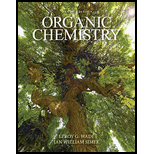
(a)
To determine: The
Interpretation: The alkyl halide that gives
Concept introduction: The elimination reaction is the organic reaction in which two substituents are removed from the organic molecule in one step or two steps. The two mechanisms of the elimination reaction are E1 and E2 mechanism.
The
In
(b)
To determine: The stereo geometry of the alkyl halide
Interpretation: The stereo geometry of the alkyl halide
Concept introduction: The geometric isomerism is shown by an organic compound. The compounds that have two higher priority groups are on the same side of the double bond are represented by Z and the compounds that have two higher priority groups on the different side of the double bond are represented by
Want to see the full answer?
Check out a sample textbook solution
Chapter 7 Solutions
Organic Chemistry Plus Mastering Chemistry with Pearson eText -- Access Card Package (9th Edition) (New in Organic Chemistry)
- The reaction Q(g) + R(g) → Z(l) is shown to be exothermic. Which of the following is true concerning the reaction. it is spontaneous only at High T, it is spontaneous at low T it is nonspontaneous at all T it is spontanrous at all T. it is non spontaneous only at low T.arrow_forwardThe reaction Q(g) + R(g) → Z(l) is shown to be exothermic. Which of the following is true concerning the reactionarrow_forwardWhich of the following has the largest standard molar entropy, S° (298.15 K) He H2 NaCl KBr Hgarrow_forward
- Which of the following is true for a particular reaction if ∆G° is -40.0 kJ/mol at 290 K and –20.0 kJ/mol at 390 K?arrow_forwardWhat is the major product of the following reaction? O O OH OH 1. BH 2. H₂O₂, NaOH OH OHarrow_forwardDraw the products formed when each ester is hydrolyzed with water and sulfuric acid.arrow_forward
 Organic Chemistry: A Guided InquiryChemistryISBN:9780618974122Author:Andrei StraumanisPublisher:Cengage Learning
Organic Chemistry: A Guided InquiryChemistryISBN:9780618974122Author:Andrei StraumanisPublisher:Cengage Learning
